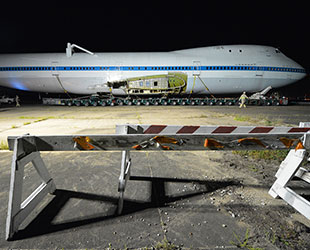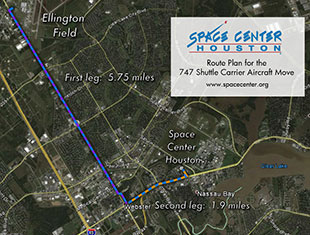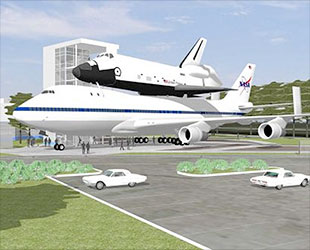April 28, 2014 — "Oversize Load."
So cautions bright orange signs now positioned alongside roads leading to and from NASA's Johnson Space Center in Houston. The traffic advisories were placed in advance of the space agency's Shuttle Carrier Aircraft (SCA) being moved, set to begin Monday night (April 28).
"Oversize" though, might be an understatement.
The Boeing 747 jumbo jet, which for three decades ferried NASA's shuttles across the country, will be transported in its current dismantled state by a convoy stretching 1,000 feet long (305 meters), including four self-propelled trailers and three tractor-trailers. The fuselage, the largest section to be moved intact, roughly spans the length of two NBA basketball courts.
Crawling at about the speed of a person walking, 3 miles per hour (4.8 kilometers per hour), the SCA will be moved nearly eight miles (12.9 km) over the course of two nights, traveling almost six miles (9.7 km) Monday and two miles (3.2 km) Tuesday. It's set to arrive early Wednesday (April 30) at Space Center Houston, Johnson's visitor center.

The largest section of the Shuttle Carrier Aircraft to be moved is the fuselage. Its length is about the height of Niagara Falls. (cS) |
Much like the 2012 move of shuttle Endeavour through the streets of Los Angeles, the SCA (which flew Endeavour piggyback to California) will require roads to be closed and obstacles along its route to be temporary moved out of its way. Unlike the shuttle's road trip though, the SCA, known by its tail number N905NA or NASA 905 for short, will only be moved at night.
"Our primary concern during the move is for the safety of our community and the workers involved," Richard Allen, president and CEO of Space Center Houston, said. "The relocation of the 747 will be a grand sight, but we want to make sure everyone affected is fully prepared for the road closures."
Workers will dismantle traffic lights, signs and utility poles so the convoy may pass, but thanks to extensive planning efforts, no utilities are expected to be interrupted.
On Monday beginning at 9 p.m. and extending to Tuesday at 4:30 a.m. CDT (0200-0930 GMT), Texas State Highway 3 from Scarsdale Blvd. to NASA Parkway (also known as NASA Road 1) will close to traffic. The convoy will depart Ellington Field and proceed to E. Commerce Street, where it will spend the day on Tuesday.

Route plan for the Shuttle Carrier Aircraft convoy from Ellington Field to Space Center Houston, April 28-30, 2014. (SCH) |
Then during the same overnight hours on Tuesday, NASA Parkway will close between Highway 3 and Saturn Lane. This second and final leg of the trip is expected to be the most challenging as a result of a large overpass sign that will need to be lifted for the SCA to pass.
Early Wednesday morning, the Shuttle Carrier Aircraft will pull into the parking lot at Space Center Houston, where the jumbo jet will go on display in 2015.
Once reassembled, the SCA will be topped with the space shuttle Independence, a high-fidelity full-size replica of the NASA orbiters. The resulting eight-story-tall attraction will give visitors the unique opportunity to tour inside both the shuttle mockup and historic aircraft.
There are no designated public viewing locations along the SCA convoy's two-night route. Space Center Houston has published however, an interactive map on its "Big Move" website to help the public plan accordingly, whether trying to navigate around the road closures or catch sight of the SCA in motion.

Artist rendering of "The Shuttle and 747 Carrier" public attraction to open at Space Center Houston in 2015. (Space Center Houston) |
NASA 905 rolled off the assembly line in 1970 as the 86th Boeing 747 that the company built (just a few days prior to NASA 905's move, Boeing completed its 1,500th 747). It first entered service as an American Airlines jetliner before being acquired by NASA in 1974.
Two years later, following modifications, NASA 905 began use as the Shuttle Carrier Aircraft, at first in support of the approach and landing tests with the prototype Enterprise orbiter, and then as the ferry transport for the space-flown shuttles. In 1990, NASA added a second SCA to its fleet, NASA 911. In 2012, NASA 905 ended its service to the space shuttle program by flying Discovery, Enterprise and Endeavour to their respective museum homes in Virginia, New York and California. In total, NASA 905 logged 3,774 flights.
